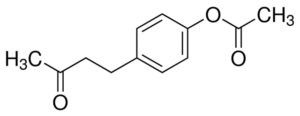Attractants and lures
Attractants or lures are used to trap fruit flies as they provide an easy way to collect large numbers of flies in a short period of time.
Host or protein attractants
Protein or host lures, such as those used in McPhail traps, were widely used in the past. They are weaker attractants than male lures but are useful for trapping species not attracted to male lures or trapping both sexes.
Newer lures include ‘cucumber volatile lure’ useful for attracting some cucurbit infesting species such as Zeugodacus cucurbitae (Siderhurst and Jang 2010), or Z. cucumis (Royer et al. 2014). Ceratraps/Ceralure is an alternate animal based wet protein lure.
Male attractants
Male attractants attract species in subfamily Dacinae (Bactrocera, Dacus, Zeugodacus and Ceratitis). Approximately 43% of Dacini respond to cue-lure or methyl eugenol (Dooreweerd et al. 2017). The remainder either have no known male lure attraction or respond to newer male lures such as zingerone, isoeugenol or methyl-isoeugenol.
The different male lures are:
- Methyl eugenol (ME) – (see structure below) attractive to pests such as Oriental fruit fly (Bactrocera dorsalis) and the banana fly (B. musae). Fewer Dacus and Zeugodacus species respond to this lure.
- Cue-lure (CL) and other ‘cue-group’ lures raspberry ketone and Melolure (raspberry ketone formate) – (see structure below) these are similar in structure and range of species attracted and are widely used in collecting Bactrocera, Dacus and Zeugodacus, including pests such as Queensland fruit fly (B. tryoni), melon fly (Z. cucurbitae) and New Guinea fly (B. trivialis) spp. Cue-lure is the most widely used.
1. Raspberry ketone (or Willison’s lure) attracts the same range of species as cue-lure but not as strongly.
2. Melolure (raspberry ketone formate) is a stronger attractant to some species than cue-lure e.g. Z. cucurbitae, B. tryoni (Casana-Giner et al. 2003; Royer 2015) but less attractive to others (e.g. B. neohumeralis (Royer 2015)).
- Zingerone – a relatively new male attractant discovered in Bulbophyllum orchids which attract fruit flies (Tan and Nishida 2000). It was found to be highly attractive to the Australian pest species B. jarvisi (Fay 2012). It also attracts several species that do not respond to cue-lure or ME in addition to some cue and ME-responsive species (Fay 2012; Royer 2015; Nishida and Tan 2016).
- Isoeugenol – a new ‘eugenol analogue’ of similar structure to ME. It is more attractive to the CL-responsive pests B. kraussi (Royer 2015) and B. curvipennis than CL (Royer et al. 2018 in prep.). It also attracts B. halfordiae (Royer 2015) a ‘non-responsive’ species that has caused some market access concern due to old citrus host records (May 1953).
- Methyl-isoeugenol is another new ’eugenol analogue’. It is more attractive to the ME-responsive pests Pacific fly B. xanthodes (Royer et al. 2018 in prep.) and Asian cucurbit flower pest Z. diversus (Royer et al. 2018) than ME.
- Capilure or Trimedlure – widely used for trapping Ceratitis spp. such as Medfly.
Male attractants are highly volatile chemicals and need only to be used in small amounts to be effective.
ME is more volatile than CL and needs to be replaced every 8-10 weeks while cue lure can remain effective for 20 weeks (Shelly et al. 2017).
Generally, a wick is impregnated with a mixture of 4 mL attractant and 1 mL or less of 50% w/v concentrate of malathion and is then suspended within the trap.
Care must be taken to avoid cross lure contamination as lure response is an important part of fruit fly identification and lure contamination may cause confusion in identifications.
Additionally, ME and CL combined greatly reduces their attractiveness to many species (Royer and Mayer 2017). It is very important that lure contamination does not occur during lure dosing, trap setup or trap clearance.

Methyleugenol structure

Cue lure structure